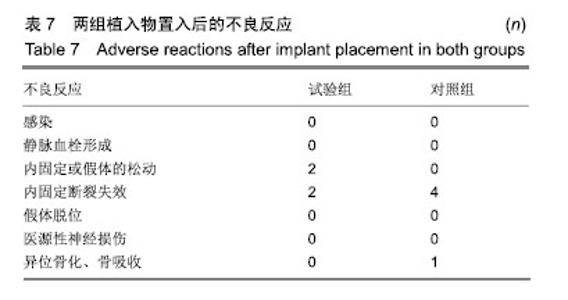Chinese Journal of Tissue Engineering Research ›› 2019, Vol. 23 ›› Issue (32): 5110-5116.doi: 10.3969/j.issn.2095-4344.1463
Previous Articles Next Articles
ISObar TTL dynamic fixation system in the treatment of double-segment lumbar disc herniation: 8-year follow-up
Cao Zongrui, Zheng Bo, Qu Bo, Jiang Tao, Qu Xiaolong, Chen Tianyi, Zhang Xiuli
- Department of Orthopedics, the First Affiliated Hospital of Chengdu Medical College, Chengdu 610500, Sichuan Province, China
-
Online:2019-11-18Published:2019-11-18 -
Contact:Jiang Tao, Master, Chief physician, Associate professor, Department of Orthopedics, the First Affiliated Hospital of Chengdu Medical College, Chengdu 610500, Sichuan Province, China -
About author:Cao Zongrui, Attending physician, Lecturer, Department of Orthopedics, the First Affiliated Hospital of Chengdu Medical College, Chengdu 610500, Sichuan Province, China -
Supported by:the Sichuan Provincial Education Department Foundation Project, No. 15AZ0265 (to JT)| the Scientific Research Topics of Health and Family Planning Commission of Sichuan Province, No. 18PJ473 (to QB)
CLC Number:
Cite this article
Cao Zongrui, Zheng Bo, Qu Bo, Jiang Tao, Qu Xiaolong, Chen Tianyi, Zhang Xiuli. ISObar TTL dynamic fixation system in the treatment of double-segment lumbar disc herniation: 8-year follow-up[J]. Chinese Journal of Tissue Engineering Research, 2019, 23(32): 5110-5116.
share this article
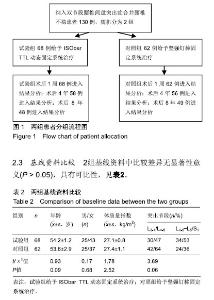
2.1 参与者数量分析 纳入双节段椎间盘突出合并腰椎不稳患者130例,随机分为2组,试验组68例,对照组62例。 术后1周,试验组68例、对照组62例全部进入结果分析,无脱落。 术后4年,试验组58例、对照组56例进入结果分析;试验组脱落10例,9例失访,1例因肺癌死亡;对照组脱落6例,5例全因失访,1例患者在术后2年中融合失败(再次手术行植骨,去除硬化骨的方法后融合成功)。 术后8年,试验组48例、对照组49例进入结果分析;试验组脱落20例,其中13例失访,3例死亡(其中2例因心脏疾病死亡,1例因为肺癌死亡),其余4例患者在术后6-8年中内固定失败(2例为低暴力致腰椎骨折合并内固定断裂,再次行内固定治疗;2例为不明原因内固定松动,去除内固定治疗);对照组脱落13例,其中8例失访,1例死亡(因心脏疾病死亡),其余4例在术后6-8年因低暴力致腰椎骨折致内固定断裂(再次行内固定治疗)。 所有随访患者未见融合失败,脱落的病例全部从统计中剔除。所有患者至少随访8年或以死亡为终点,平均随访时间为9.2年。 2.2 试验流程图 见图1。"
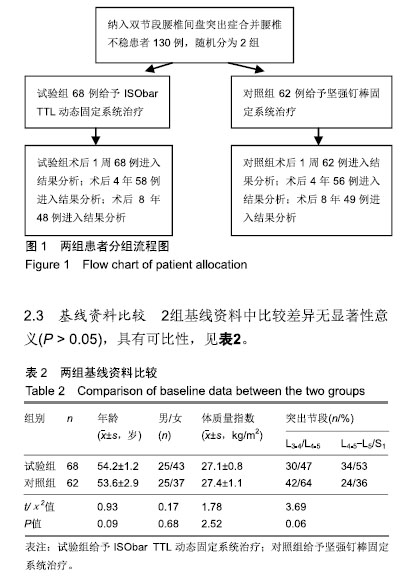
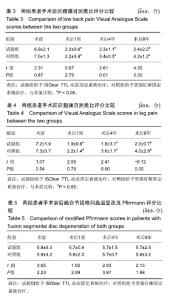
2.4 两组患者腰痛及腿痛目测类比评分 与术前相比,试验组与对照组患者术后1周、4年、8年的腰痛及腿痛目测类比评分均明显改善,差异有显著性意义(P < 0.05)。组间对比,2组术前及术后1周腰痛及腿痛目测类比评分差异无显著性意义(P > 0.05);但是术后4,8年试验组腰痛及腿痛测类比评分明显低于对照组,差异有显著性意义(P < 0.05),见表3,4。 2.5 两组患者融合节段椎间盘退变改良Pfirrmann分级评分 与术前相比,试验组与对照组患者术后1周、4年、8年的融合节段椎间盘退变改良Pfirrmann分级评分无明显变化(P > 0.05)。组间对比,2组术前及术后1周、4年、8年融合节段椎间盘退变改良Pfirrmann分级评分差异无显著性意义(P > 0.05),见表5。"
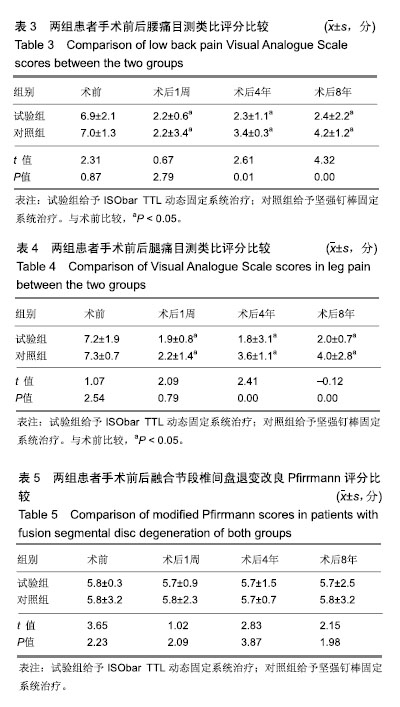
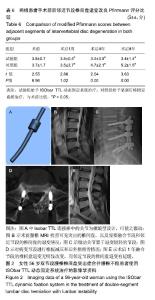
2.6 两组患者邻近节段椎间盘退变改良Pfirrmann分级评分 与术前相比,试验组与对照组患者术后1周、4年、8年的邻近节段椎间盘退变改良Pfirrmann评分均明显改善,差异有显著性意义(P < 0.05)。试验组术后改良Pfirrmann分级评分逐年降低,退变好转;对照组术后改良Pfirrmann分级评分逐年增加,退变有加重趋势。 组间对比,2组术前及术后1周邻近节段椎间盘退变改良Pfirrmann评分差异无显著性意义(P > 0.05);术后4,8年,试验组邻近节段椎间盘退变改良Pfirrmann评分均显著低于对照组(P < 0.05),见表6。 2.7 典型病例 女性患者,56岁,腰腿不适3年,2周前症状明显加重,出现腰腿疼痛,双下肢麻木感;查体示:腰部压痛,双下肢足外侧皮肤感觉减退,右足踇趾跖屈肌力3级,左足踇趾跖屈肌力2级,双下肢支直腿抬高试验(+),病理反射(-);MRI示:L4/5及L5/S1椎间盘突出。给予ISObar TTL动态固定系统治疗双节段腰椎椎间盘突出症,相关影像学资料见图2。"

| [1]Qian J, Bao Z, Li X, et al. Short-term therapeutic efficacy of the isobar ttl dynamic internal fixation system for the treatment of lumbar degenerative disc diseases. Pain Physician. 2016;19(6):E853-E861.[2]Xing R, Dou Q, Li X, et al. Posterior dynamic stabilization with direct pars repair via wiltse approach for the treatment of lumbar spondylolysis: the application of a novel surgery. Spine (Phila Pa 1976).2016;41(8):E494-E502.[3]Silva P, Rosa RC, Shimano AC, et al. Effect of pilot hole on biomechanical and in vivo pedicle screw-bone interface.Eur Spine J.2013;22(8):1829-1836.[4]Bronsard N, Serre T, Staccini P, et al.Biometric and biomechanic analysis of lumbar posterior facets based on a CT-scan database. Morphologie.2013;97(316): 19-28.[5]Mu X, Wei J, A J, et al. The short-term efficacy and safety of artificial total disc replacement for selected patients with lumbar degenerative disc disease compared with anterior lumbar interbody fusion: A systematic review and meta-analysis. PLoS One.2018;13(12):e0209660.[6]Gao J, Zhao W, Zhang X, et al. MRI analysis of the ISOBAR TTL internal fixation system for the dynamic fixation of intervertebral discs: a comparison with rigid internal fixation. J Orthop Surg Res. 2014;9:43.[7]Griffith JF, Wang YX, Antonio GE, et al. Modified Pfirrmann grading system for lumbar intervertebral disc degeneration. Spine. 2007;32(24):708-712. [8]Watanabe K, Matsumoto M, Tsuji T, et al. Ball tip technique for thoracic pedicle screw placement in patients with adolescent idiopathic scoliosis.Neurosurg Spine. 2010;13: 246-252.[9]冯学烽,章凯,涂强,等.ISOBAR TTL动态固定治疗多节段腰椎退行性病变的早期疗效[J].中国骨科临床与基础研究杂志,2017, 9(5):274-279.[10]Huang W, Shao G, Li B, et al.Influence of isobar ttl dynamic internal fixation system on adjacent segment degeneration by mri measurement of lumbar nucleus pulposus volume. Zhongguo Xiu Fu Chong Jian Wai Ke Za Zhi.2016;30(7): 855-860.[11]Levin JM, Tanenbaum JE, Steinmetz MP, et al. Posterolateral fusion (PLF) versus transforaminal lumbar interbody fusion (TLIF) for spondylolisthesis: a systematic review and meta-analysis.Spine J.2018;18(6):1088-1098.[12]Hasegewa K, Kitahara K, Hara T, et al. Biomechanical evaluation of segmental instability in degenerative lumbar spondylolisthesis. Eur Spine J. 2009;18(4):465-470.[13]马亮,许永涛,佘远举.腰椎融合联合上一节段棘突间动态固定的有限元分析[J].中国组织工程研究,2018,22(23):3647-3653.[14]Ye F, Zeng Z, Wang J, et al. Comparison of the use of rhBMP-7 versus iliac crest autograft in single-level lumbar fusion: a meta-analysis of randomized controlled trials. J Bone Miner Metab.2018;36(1):119-127.[15]Delawi D, Jacobs W, van Susante JL, et al. OP-1 compared with iliac crest autograft in instrumented posterolateral fusion: a randomized, multicenter non-inferiority trial. J Bone Joint Surg Am.2016;98(6):441-448.[16]Luo J, Cao K, Yu T, et al. Comparison of posterior lumbar interbody fusion versus posterolateral fusion for the treatment of isthmic spondylolisthesis. Clin Spine Surg. 2017;30(7): E915-E922.[17]Dang ABC, Hong H, Lee K, et al. Repurposing human osteoarthritic cartilage as a bone graft substitute in an athymic rat posterolateral spinal fusion model. Int J Spine Surg. 2018; 12(6):735-742.[18]Zhu ZH, Cao P, Liang Y, et al. Experimental study of laparoscopical lumbar interbody fusion with polyporus composite phosphate calcium and rhBMP-2 compounds in sheep. Zhonghua Yi Xue Za Zhi.2010;90(21):1503-1506.[19]姚欣强,蒋晖,程勇泉,等.Isobar TTL系统治疗腰椎退行性疾病的中长期随访结果[J].中国矫形外科杂志,2017,25(3):199-203.[20]田一星,包肇华,邹俊,等.单节段Isobar TTL系统动态内固定治疗腰椎退行性疾病的短期效果[J].中国组织工程研究,2018,22(7): 1020-1025.[21]Qian J, Bao Z, Li X, et al. Short-Term Therapeutic Efficacy of the isobar TTL dynamic internal fixation system for the treatment of lumbar degenerative disc diseases. Pain Physician.2016;19(6):E853-E861.[22]Chamoli U, Diwan AD, Tsafnat N. Pedicle screw-based posterior dynamic stabilizers for degenerative spine: in vitro biomechanical testing and clinical outcomes.J Biomed Mater Res A.2014;102(9):3324-3340.[23]Li Z, Li F, Yu S, et al. Two-year follow-up results of the Isobar TTL Semi-Rigid Rod System for the treatment of lumbar degenerative disease.J Clin Neurosci. 2013;20(3):394-399.[24]史舅生,张国平,方文,等.单侧与双侧椎弓根钉内固定椎体间融合术治疗腰椎退行性疾病的比较[J].中国骨与关节损伤杂志, 2018, 33(3):292-294.[25]Yu AK, Siegfried CM, Chew B, et al. Biomechanics of posterior dynamic fusion systems in the lumbar spine: implications for stabilization with improved arthrodesis. Clin Spine Surg. 2016,29(7):E325-E330.[26]Han YC, Liu ZQ, Wang SJ, et al. Comparison of unilateral versus bilateral pedicle screw fixation in degenerative lumbar diseases:a meta-analysis. Eur Spine J. 2014;23(5):974-984.[27]吕建华,唐昭惠,陈凯,等.半坚强与坚强内固定邻近节段腰椎间盘角位移及应力的比较[J].中国组织工程研究,2016,20(9):1275-1281.[28]Khechen B, Haws BE, Patel DV, et al. Comparison of postoperative outcomes between primary MIS TLIF and MIS TLIF with revision decompression. Spine (Phila Pa 1976). 2019,44(2):150-156. |
| [1] | Hu Kai, Qiao Xiaohong, Zhang Yonghong, Wang Dong, Qin Sihe. Treatment of displaced intra-articular calcaneal fractures with cannulated screws and plates: a meta-analysis of 15 randomized controlled trials [J]. Chinese Journal of Tissue Engineering Research, 2021, 25(9): 1465-1470. |
| [2] | Xu Feng, Kang Hui, Wei Tanjun, Xi Jintao. Biomechanical analysis of different fixation methods of pedicle screws for thoracolumbar fracture [J]. Chinese Journal of Tissue Engineering Research, 2021, 25(9): 1313-1317. |
| [3] | Zhang Tongtong, Wang Zhonghua, Wen Jie, Song Yuxin, Liu Lin. Application of three-dimensional printing model in surgical resection and reconstruction of cervical tumor [J]. Chinese Journal of Tissue Engineering Research, 2021, 25(9): 1335-1339. |
| [4] | Yao Rubin, Wang Shiyong, Yang Kaishun. Minimally invasive transforaminal lumbar interbody fusion for treatment of single-segment lumbar spinal stenosis improves lumbar-pelvic balance [J]. Chinese Journal of Tissue Engineering Research, 2021, 25(9): 1387-1392. |
| [5] | Du Xiupeng, Yang Zhaohui. Effect of degree of initial deformity of impacted femoral neck fractures under 65 years of age on femoral neck shortening [J]. Chinese Journal of Tissue Engineering Research, 2021, 25(9): 1410-1416. |
| [6] | Zhang Shangpu, Ju Xiaodong, Song Hengyi, Dong Zhi, Wang Chen, Sun Guodong. Arthroscopic suture bridge technique with suture anchor in the treatment of acromioclavicular dislocation [J]. Chinese Journal of Tissue Engineering Research, 2021, 25(9): 1417-1422. |
| [7] | Zhou Jihui, Li Xinzhi, Zhou You, Huang Wei, Chen Wenyao. Multiple problems in the selection of implants for patellar fracture [J]. Chinese Journal of Tissue Engineering Research, 2021, 25(9): 1440-1445. |
| [8] | Chen Junming, Yue Chen, He Peilin, Zhang Juntao, Sun Moyuan, Liu Youwen. Hip arthroplasty versus proximal femoral nail antirotation for intertrochanteric fractures in older adults: a meta-analysis [J]. Chinese Journal of Tissue Engineering Research, 2021, 25(9): 1452-1457. |
| [9] | Xu Yulin, Shen Shi, Zhuo Naiqiang, Yang Huilin, Yang Chao, Li Yang, Zhao Heng, Zhao Lu. Biomechanical comparison of three different plate fixation methods for acetabular posterior column fractures in standing and sitting positions [J]. Chinese Journal of Tissue Engineering Research, 2021, 25(6): 826-830. |
| [10] | Hou Guangyuan, Zhang Jixue, Zhang Zhijun, Meng Xianghui, Duan Wen, Gao Weilu. Bone cement pedicle screw fixation and fusion in the treatment of degenerative spinal disease with osteoporosis: one-year follow-up [J]. Chinese Journal of Tissue Engineering Research, 2021, 25(6): 878-883. |
| [11] | He Li, Tian Wei, Xu Song, Zhao Xiaoyu, Miao Jun, Jia Jian. Factors influencing the efficacy of lumbopelvic internal fixation in the treatment of traumatic spinopelvic dissociation [J]. Chinese Journal of Tissue Engineering Research, 2021, 25(6): 884-889. |
| [12] | Yang Weiqiang, Ding Tong, Yang Weike, Jiang Zhengang. Combined variable stress plate internal fixation affects changes of bone histiocyte function and bone mineral density at the fractured end of goat femur [J]. Chinese Journal of Tissue Engineering Research, 2021, 25(6): 890-894. |
| [13] | Zhang Lei, Ma Li, Fu Shijie, Zhou Xin, Yu Lin, Guo Xiaoguang. Arthroscopic treatment of greater tuberosity avulsion fractures with anterior shoulder dislocation using the double-row suture anchor technique [J]. Chinese Journal of Tissue Engineering Research, 2021, 25(6): 895-900. |
| [14] | Yuan Xinping, Shao Yanbo, Wu Chao, Wang Jianling, Tong Liangcheng, Li Ying. Accuracy of target bone segments in personalized differential modeling and simulation of CT scanning parameters at fracture end [J]. Chinese Journal of Tissue Engineering Research, 2021, 25(6): 912-916. |
| [15] | Song Chengjie, Chang Hengrui, Shi Mingxin, Meng Xianzhong. Research progress in biomechanical stability of lateral lumbar interbody fusion [J]. Chinese Journal of Tissue Engineering Research, 2021, 25(6): 923-928. |
| Viewed | ||||||
|
Full text |
|
|||||
|
Abstract |
|
|||||
